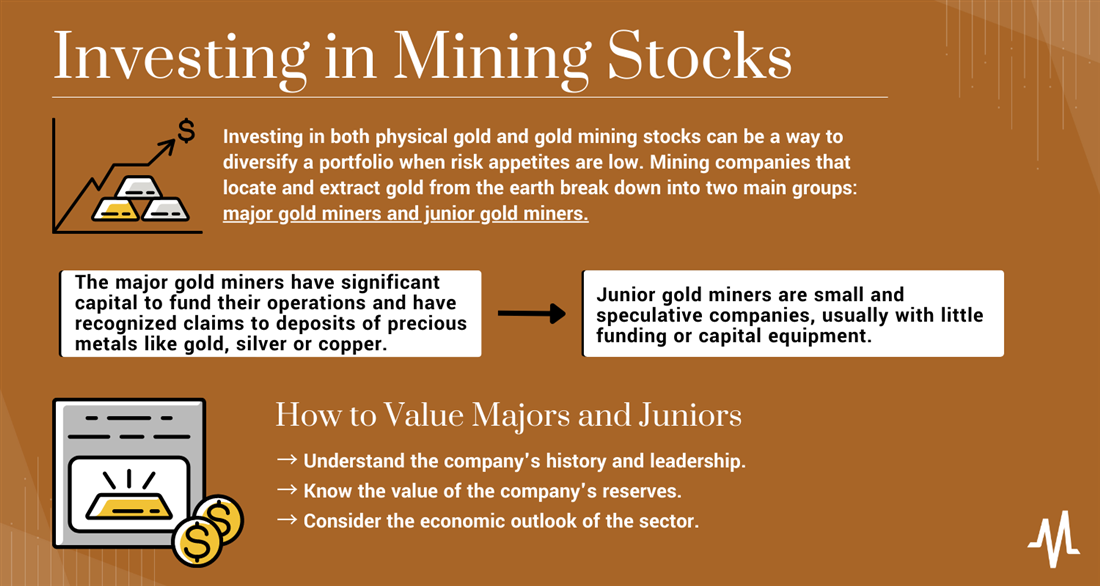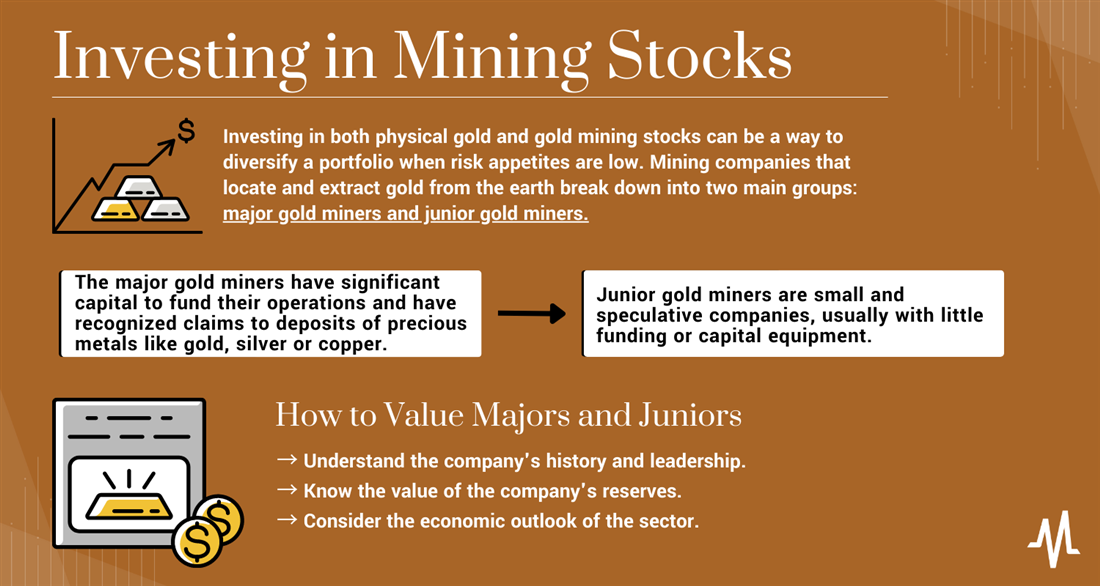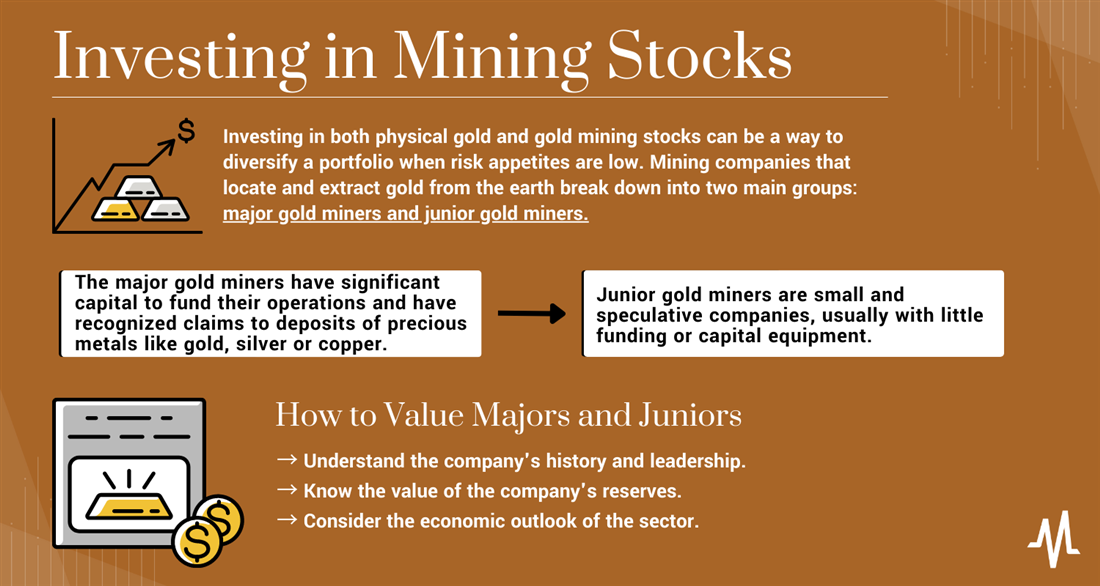To learn how to invest in mining companies and how to invest in gold mining stocks specifically, you'll need to evaluate the individual firms and the future outlook of commodities like gold and silver, then determine whether an investment is worth the risk.
Mining Stock Groups
Precious metals like gold and silver have countless practical uses and have long been considered safe-haven investments for times of economic turbulence. Gold prices tend to have low volatility, and investing in both physical gold and gold mining stocks can be a way to diversify a portfolio when risk appetites are low.
Tucking a bunch of gold bars in a basement safe usually isn't the way to long-term outperformance, though, so be sure to understand the trade-offs when investing in mining companies and "safe" assets like gold.
Gold is buried in the ground and, like oil, must be mined and refined for public use. You can find gold deposits worldwide, but South Africa's Witwatersrand mines are responsible for 40% of the total mined gold supply. Mining companies that locate and extract gold from the earth break down into two main groups: major gold miners and junior gold miners.
Majors
The major gold miners are the big boys in the gold stock sector. These companies not only have significant capital to fund their operations (mining gold is time-consuming and expensive!), but they have recognized claims to deposits of precious metals like gold, silver or copper. Some of the publicly-traded companies in this section of the market include Barrick Gold Corp. (NYSE: GOLD), Newmont Corp. (NYSE: NEM) and BHP Group Ltd. (NYSE: BHP).
Juniors
If the majors are the sector's biggest and most well-capitalized companies, you can guess what category the junior gold miners fall into. Junior gold miners are small and speculative companies, usually with little funding or capital equipment. Most importantly, these companies don't have a claim on any precious metal or commodity resources. Instead, they're searching for deposits or attempting to set up operations. Most junior gold miners fail, but they can strike it rich if they find a resource deposit. Junior gold miners are often small-cap or micro-cap companies; many don't trade on major exchanges like the NYSE or Nasdaq. Since these companies are small and risky, many investors prefer to trade them through ETFs.


 How to Value Majors and Juniors
How to Value Majors and Juniors
Understanding the risk and rewards of major and junior gold mining companies is an important key to investing in mining stocks. While gold prices strongly influence mining companies' prospects, other factors can be just as crucial.
Step 1: Understand the company's history and leadership.
Company history is an important factor when evaluating a gold mining stock. Firms like Barrick Gold and Newmont, with their long track records of success, will be rewarded with less volatile stock price movement. Additionally, the longest-tenured companies tend to be best at managing their capital and efficiently extracting the commodity.
Step 2: Know the value of the company's reserves.
Investors have an advantage when evaluating gold mining company stocks against other equities. It is fairly straightforward to determine how much gold a company has in reserve and how much it expects to produce from its operations. And while no company knows exactly how much gold they can reap for a particular deposit, certain reports known as feasibility studies estimate the quality and size of the deposit against the costs of operations.
Step 3: Consider the economic outlook of the sector.
Finally, consider the state of the global economy and the projection of long-term gold prices. When economies are booming, gold still has value as a luxury item and industrial material, but investment appetite in risk-off assets declines. If gold prices fall, junior miners may struggle to get funding or continue operating. If the economic outlook is shaky and gold prices rise, miners may find themselves with additional cash and incentives.
How to Invest in Mining Stocks
If you've decided that an investment in the sector might be worthwhile, here's how to buy gold mining stocks in a way that fits your portfolio and long-term goals.
Step 1: Evaluate the economic climate.
Before looking at any particular stocks or ETFs to invest in mining, you'll need to look at the global economic situation and consider how gold prices may respond in the long and short term. All gold mining companies have different types of operations and access to capital, but they do have one thing in common: their dependence on the price of the underlying commodity.
If gold prices decline in the future, even the most well-run and deep-pocketed gold mining company will struggle to keep its stock price up.
Step 2: Consider the type of investment you want to make.
Gold miners are volatile, especially the speculative junior miners that don't have access to any resource deposits. Stock picking isn't for everyone, so if the thought of sifting through company balance sheets and feasibility studies doesn't appeal, consider investing in mining stocks through an ETF.
ETF providers often have options for majors and juniors, like the VanEck Gold Miners ETF (NYSE: GDX) and the VanEck Junior Gold Miners ETF (NYSE: GDXJ). Note that gold miner ETFs tend to have high expense rates, and many use leverage to juice potential returns, so make sure you understand the fund's goals before buying shares.
Step 3: Develop an investment plan and profit goals.
What are your goals with an investment in gold mining stocks? Is it long-term capital appreciation, or do you expect a short-term surge in gold prices? And how much capital are you willing to put into a mining investment? You'll want to map out your investment parameters before risking any money. If you don't plan on when to take profits or cut losses, you'll put yourself at a higher risk of making a mistake.
Step 4: Buy mining stock shares and monitor your investment.
Some junior gold miners are low-priced stocks like pennies and don't trade on the major U.S. exchanges, so you'll always need to confirm that shares are available at your particular broker. But major gold miners like Barrick and Newmont have large market caps and liquid shares, as do most gold mining ETFs. Buy your shares and keep track of your investments. And always remember that gold mining stocks have additional risks beyond just the volatility of the spot price of gold.
Risks of Investing in Mining Stocks
Learning how to invest in mining also requires understanding the risks involved with the industry. Gold has long been favored as a portfolio diversification tool and as a hedge against inflation and uncertainty. But do the numbers bear that out?
- Gold versus other safe assets: Is gold really a hedge against inflation? Gold prices soared in the 1970s when inflation was high, but recent inflationary periods have been less than kind to gold investors. Some data show that Treasuries may be a better way to combat inflation than gold investments.
- Company stability: Junior gold miners are an extremely volatile and risky market sector. Many of these companies have limited access to funding and will never find a dependable source of metal to extract and refine. Without actually "striking gold," these companies will wither and fade.
- Significant capital required: Finding gold is a little tougher than Hollywood movies make it seem. Many gold deposits are inaccessible due to costs (like the ones in the ocean), while other operations may be risky due to unstable government regimes or economies. But getting gold from the ground and into the jewelry boxes of consumers is a costly process, and companies can be left with high debt loads if extraction yields are less than expected.
- Environmental concerns: Gold may not be burned in combustion engines, but its extraction is still bad for local ecosystems. Gold mining can contaminate drinking water with toxic chemicals and harm animal populations through deforestation and waste production.
Riskier than Physical Gold
If you want to add gold exposure to your portfolio, you must decide whether to own physical gold or gold miners. ETFs like the SDPR Gold Shares ETF (NYSE: GLD) make it easy to "own" physical gold since the funds have bullion sitting in a vault. But investors who don't mind additional volatility might consider gold miners, who have more risks attached but also the potential for more significant returns.
Gold miner investments have some advantages. Tax treatment is often more favorable, and some major gold miners even pay dividends to shareholders, something you definitely won't get from owning a slab of metal. But gold miners can have company risks, and their stock prices may not always match the gyrations of the gold spot price. Many junior gold miners will still fail even if gold prices accelerate. Always know the unique risks of gold miners compared to gold bullion before investing.
FAQs
Want to know more about how to invest in mining stocks? Here are a few of the most commonly asked questions regarding the mining industry.
What is a mining stock?
A mining stock is a company that seeks to find commodities through natural deposits and extract them for refinement. We mostly discussed gold mining stocks in this article, but other mining companies look for silver, copper, iron ore and energy commodities like oil and natural gas.
What is the best way to invest in mining stocks?
The best way to invest in mining stocks depends on your goals and risk tolerance. If you don't mind volatility and can evaluate individual companies, you could build an investment by selecting mining company stocks. But if you aren't comfortable with that risk and time commitment, ETFs may be the better route.
Are mining stocks a good buy?
Mining stock returns can beat the market if the individual companies find new deposits and can increase their output. Still, mining companies also have risks that other stocks (or investors in physical gold bullion) don't. The decision to invest in mining companies depends on how you think the price of gold will perform and which mining stocks have the best odds of beating their peers.
